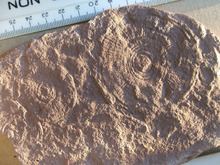Genus EdiacariaSprigg, 1947 | ||
 | ||
Similar Cyclomedusa, Aspidella, Charniodiscus, Spriggina, Dickinsonia | ||
Ediacaria is a fossil genus dating to the Ediacaran Period of the Neoproterozoic Era. Unlike most Ediacaran biota which disappeared almost entirely from the fossil record at the end of the Period, Ediacaria fossils have been found dating from the Baikalian age (850–650 Ma) of the Upper Riphean to 501 million years ago, well into the Cambrian Period. Ediacaria consists of concentric rough circles, radial lines between the circles and a central dome, with a diameter from 1 to 70 cm.
Systematics and taxonomy
Ediacaria was named by Reg Sprigg in 1947, after the Ediacara Hills (from Aborigine Idiyakra "water is present" or a mispronunciation of Yata Takarra, "hard/stony ground"[1]) in South Australia. Two species are recognised: E. flindersi, described by Sprigg from the Pound Quartzite in the Ediacara Hills, and E. booleyi, described in 1995 from a Late Cambrian deposit at Booley Bay (County Wexford), Ireland. The species were named after the Flinders Ranges and Booley Bay, respectively.
Ediacaria is possibly a synonym for Aspidella terranovica described in 1872. Although Ediacaria is one of the first described organisms from the Precambrian, Aspidella was described earlier, although its age was not understood to be Precambrian. As Aspidella is apparently a form taxon, Ediacaria may yet be valid and denote one specific genus among several that seem to make up Aspidella. Spriggia wadea is quite likely a synonym of Ediacaria (and consequently, possibly Aspidella); the differences seem to be merely due to different substrate in which the animals were embedded. (Gehling et al. 2000)
Ediacaria was often classified as a jellyfish (a Scyphozoan Cnidarian), and has also been interpreted in many of the categories postulated to house the Ediacaran biota. A conspicuous filamentous microstructure preserved in some pyritised specimens suggests that it may have been a microbial colony, which disrupted the surrounding microbial mat to create the distinctive pattern (Grazhdankin, in press).
